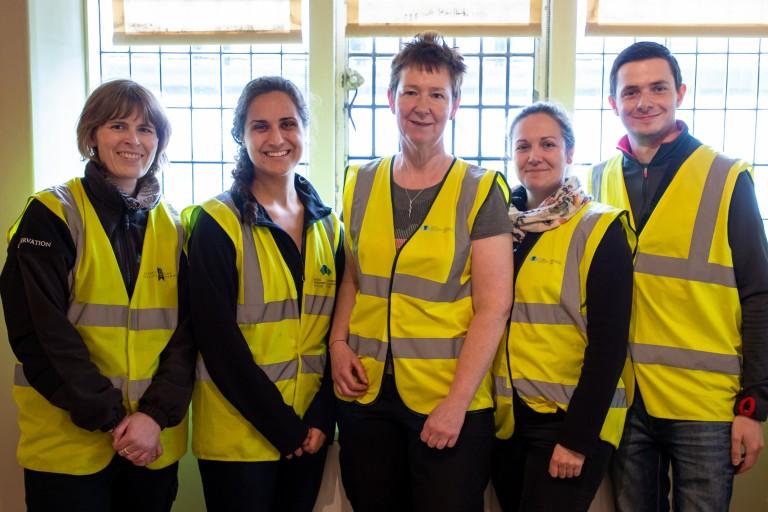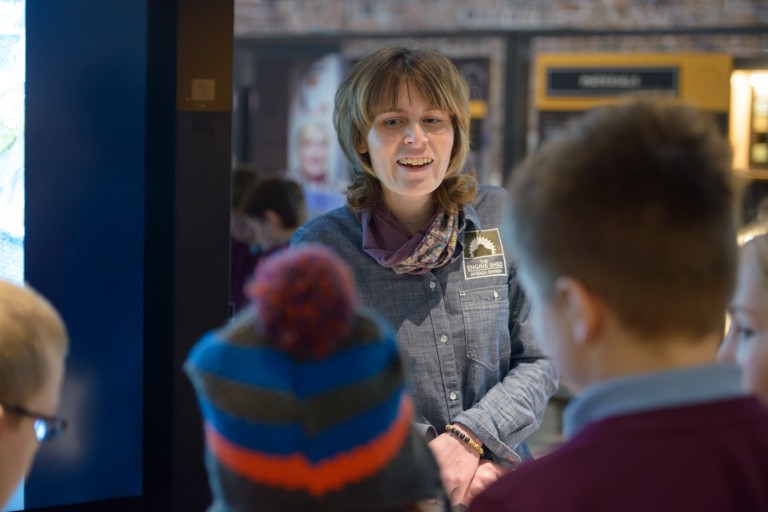What is a conservation scientist? What do they do? And how do they do it? Sarah Hamilton is one of four scientists based at our conservation centre in Stirling and is here to help you find out.
From analysing some of the most spectacular and rare fossils in the British Isles, to data processing from the kitchen table in the time of COVID-19, read on to learn more about the life of a conservation scientist.

Conservation Scientist Sarah, Digital Project Officer for the Hill House Sophia, and Conservation Scientists Maureen, Aurélie and Callum.
What does a conservation scientist do?
Our team of four help to inform decisions about the conservation of properties and collections in the care of Historic Environment Scotland and beyond. We focus on the use of non-destructive techniques to minimise impact on historic places and objects.
One strand of our work involves scientific analysis of traditional building materials. This can include anything from stone, mortar and plaster to glass, metals and paint.
Sometimes rather more unusual materials and objects cross our path too!
We’ve analysed an early-medieval bone tuning peg for traces of metal and spent a day analysing a Van Gogh painting to help understand the pigments he used.
We use this analysis to answer questions around what the material is made of to identify a suitable match for repairs or understand why a material has decayed.
The second strand of our work involves on-site condition monitoring. This includes monitoring moisture ingress and the impact of measures introduced to combat problems. It can also include identifying the need for energy efficiency improvements and monitoring the effectiveness of solutions.
What does a typical work day look like for you?

Sarah analysing samples in our lab at the Engine Shed.
In pre-COVID times, a typical day might involve a site visit to undertake analysis, collect samples or download data from equipment that’s monitoring over a period of time.
This is the really fun part of the job, with the opportunity to visit some quite amazing places!
We’ve been working on some longer-term projects at St Andrews Cathedral Museum and Fossil Grove SSSI in Glasgow and spent a great deal of time at these fascinating sites over the past few years.
However, it’s not all so glamorous!
For every day spent on site, there can be many more days (or even weeks) spent preparing and analysing samples in the lab. We process and interpret vast amounts of data and write reports.
We also spend a lot of time planning our site work, communicating with a range of stakeholders and keeping records of work up to date.
Inevitably, lockdown has put a hold on our site visits and my typical work day is now spent at my kitchen table. However, it has presented an opportunity for us to focus some time on catching up with data processing and reporting.
What helps keep you motivated during your work day?
The variety of interesting work we’re asked to do is definitely the main thing that keeps me motivated.
On a more practical level, when I’m working at the Engine Shed, I like to get out for a walk at lunchtime for some fresh air and a change of scenery.
Keeping motivated while working from home is a different challenge as I find it a long day in front of the computer.
I’ve started going for a quick walk first thing, which definitely makes me feel brighter when I turn on the laptop.
Trying to break up the day by setting out time for focusing on different tasks also helps my concentration and motivation.
What are the daily challenges you face as a conservation scientist and how do you overcome them?
We can be asked to look at and advise on a huge range of traditional materials. Some experts might dedicate their working life to studying just one of these materials so it can be a challenge to have a working knowledge across the board.
I think good background research, discussion with colleagues and knowing when external advice should be sought are the best approaches.
What about challenging projects?
Our project at Fossil Grove Site of Special Scientific Interest (SSSI) presented us with various challenges in the collection of less conventional data but gave us the opportunity to try out some new approaches.
The site contains the fossilised remains of 325-million-year-old tree stumps and their root systems, all preserved in their growth positions and is unique in the world (do check it out as it’s an amazing sight!).
However, the condition of the fossils is being impacted by water ingress and salt growth. The source of much of the water ingress was unclear, so one idea my colleague, Callum Graham, had was to use time-lapse cameras.
These are fairly inexpensive cameras and produce video footage from very good quality images taken at regular intervals.
The footage was then compared with local weather data. This helped confirm the presence of a roof leak in an area also badly affected by dripping condensation. It demonstrated how effective a simple technique can be.
What aspects about being a conservation scientist might be a surprise to others?

Pupils from Cornton Primary School attending a British Science Week workshop at the Engine Shed.
We get involved in quite a lot of outreach activities. As an ex-teacher, the school-based events are always a highlight for me! One particularly unusual but hugely enjoyable event we were part of was a project called ‘Superwomen of Science’ with Electric Voice Theatre in 2018.
The project aimed to promote the work of current and historic female scientists. It focused on the Engine Shed, the work of the Conservation Science team and historic scientists from the Stirling area.
Data from some of our analysis at the Argyle Tower in Edinburgh Castle was used as inspiration for musical compositions by a group of music students from Stirling High School.
Groups from two local primary schools also visited the Engine Shed to take part in a series of hands-on activities. They learned about the materials used in the building, different types of decay, and some of the methods we use to investigate buildings and materials.
Francis from Electric Voice Theatre then encouraged the pupils to create music, songs and actions using some of the things they had learned in these activities during her creative workshops.
The whole project culminated in an evening performance titled ‘Echoes from the Engine Shed’. Hopefully we inspired some of the conservation scientists of the future!
What are the most enjoyable parts of your working day?
Normally this would be site visits. We’re lucky to get access-all-areas entry to sites when carrying out a lot of our work, which is quite a privilege. Apart from the sites already mentioned, Skelmorlie Aisle and the Hill House are highlights.
I also enjoy meeting and working with other teams in the organisation and learning from them. It’s amazing to see what we can achieve when we work together. The 3D model of Fossil Grove produced by the Digital Innovation and Learning Team is a tremendous outreach resource. What’s more, it was an invaluable tool for us when we set out to map the condition of the fossil floor.
It’s perhaps a little to harder to choose while working from home! However, I do enjoy the peace and quiet to focus on work compared to life in an open-plan office.
Meet the teams
Meet six of our staff members to learn about their work and our building in this short film.
Articolo tratto dal blog Historic Environment Scotland
© Historic Environment Scotland – Scottish Charity No. SC045925

